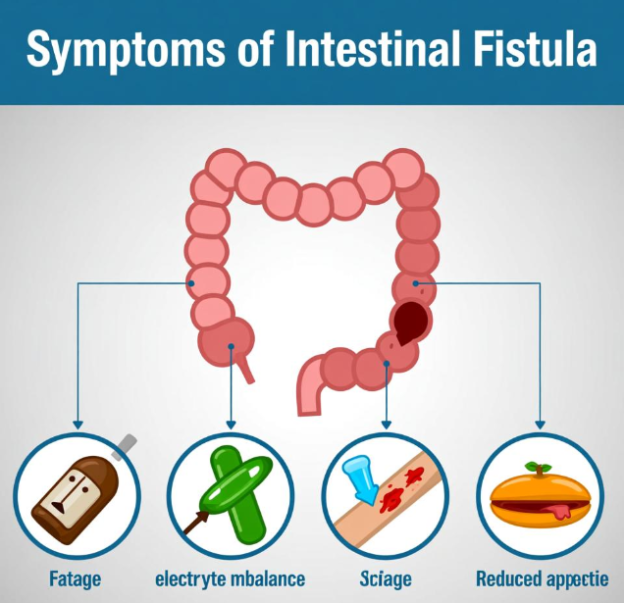An intestinal fistula is an abnormal passage between the bowel and another organ or the skin, allowing digestive fluid, food residue, or stool to leak, producing a spectrum of clinical manifestations.
The most common symptom is abdominal pain, usually persistent or colicky, located in the segment where the fistula arises.
Diarrhea is frequent, with watery or pasty stools caused by loss of digestive fluid and reduced absorptive surface.
Fever indicates accompanying infection, presenting as remittent or sustained high temperature, often with chills.
Rapid weight loss with fatigue and poor appetite results from malabsorption and hyper-catabolism.
When the tract opens into the bladder, pneumaturia, fecaluria and recurrent urinary tract infections occur; when into the vagina, passage of gas, fluid or stool is noted.
A cutaneous opening on the abdominal wall or perineum drains feculent fluid continuously, causing local pain, erosion, and excoriation.
In the acute postoperative phase sudden severe abdominal pain, guarding, tachycardia and hypotension may signal diffuse peritonitis or sepsis.
| # | Symptom / Sign | Description |
|---|---|---|
| 1 | Abdominal pain | Persistent or colicky, localized to the involved segment |
| 2 | Diarrhea | Frequent watery or pasty stools from fluid loss & poor absorption |
| 3 | Fever | Remittent or sustained high temperature with chills; implies infection |
| 4 | Weight loss & fatigue | Rapid loss plus anorexia due to malabsorption & hyper-catabolism |
| 5 | Pneumaturia / fecaluria | Gas or stool in urine when fistula opens into bladder |
| 6 | Recurrent UTI | Repeated urinary infections from bacterial contamination |
| 7 | Vaginal passage of gas/stool | Noted when tract communicates with vagina |
| 8 | Cutaneous drainage | Continuous feculent fluid from abdominal/perineal opening |
| 9 | Skin erosion & excoriation | Local pain, redness, breakdown caused by effluent |
| 10 | Acute post-operative signs | Sudden severe pain, guarding, tachycardia, hypotension → possible peritonitis/sepsis |

